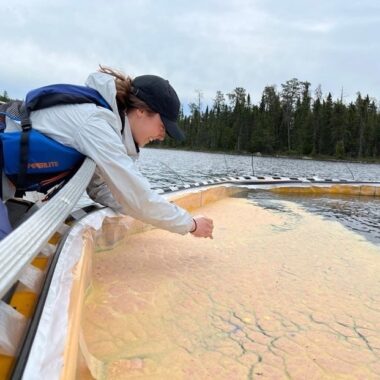
Jessie Wilson is a Master’s student in Dr. Mark Mallory’s lab studying how microplastics move through freshwater ecosystems. Jessie’s field work is at the world famous IISD Exeperimental Lakes Area and is part of a long term microplastics study. Jessie says, “with an estimated 335 trillion tons of plastics produced globally and roughly 80% of those plastics finding their way into the environment, I believe it is important to assess the fate, movement and effects this contaminant can have on biota”.
Research Objective & Methods Overview
To determine whether amphibians move microplastics (particles < 5 mm in diameter) out of aquatic habitat and into surrounding terrestrial soil.
Three common microplastics (MPs; polyethylene, polystyrene and polyethylene-teraphalate) were dyed distinct colours and ground to sizes 40-1200 µm.
Wood Frogs: Wood Frog (Lithobates sylvaticus) tadpoles were raised in tanks with high concentrations of MPs (500,000 MP/L). Tadpoles metamorphosized into terrestrial frogs, moving out onto islands, and soil from those sites was collected and analysed for the presence of MPs.
Tree Swallows: A natural lake will receive MPs, starting with MP corrals followed by whole-lake dosing. Nest boxes were installed surrounding this and a control lake. I will test for MPs in the faeces of Tree Swallow (Tachycineta bicolour) chicks nesting surrounding both lakes.


 Acadia University
Acadia University